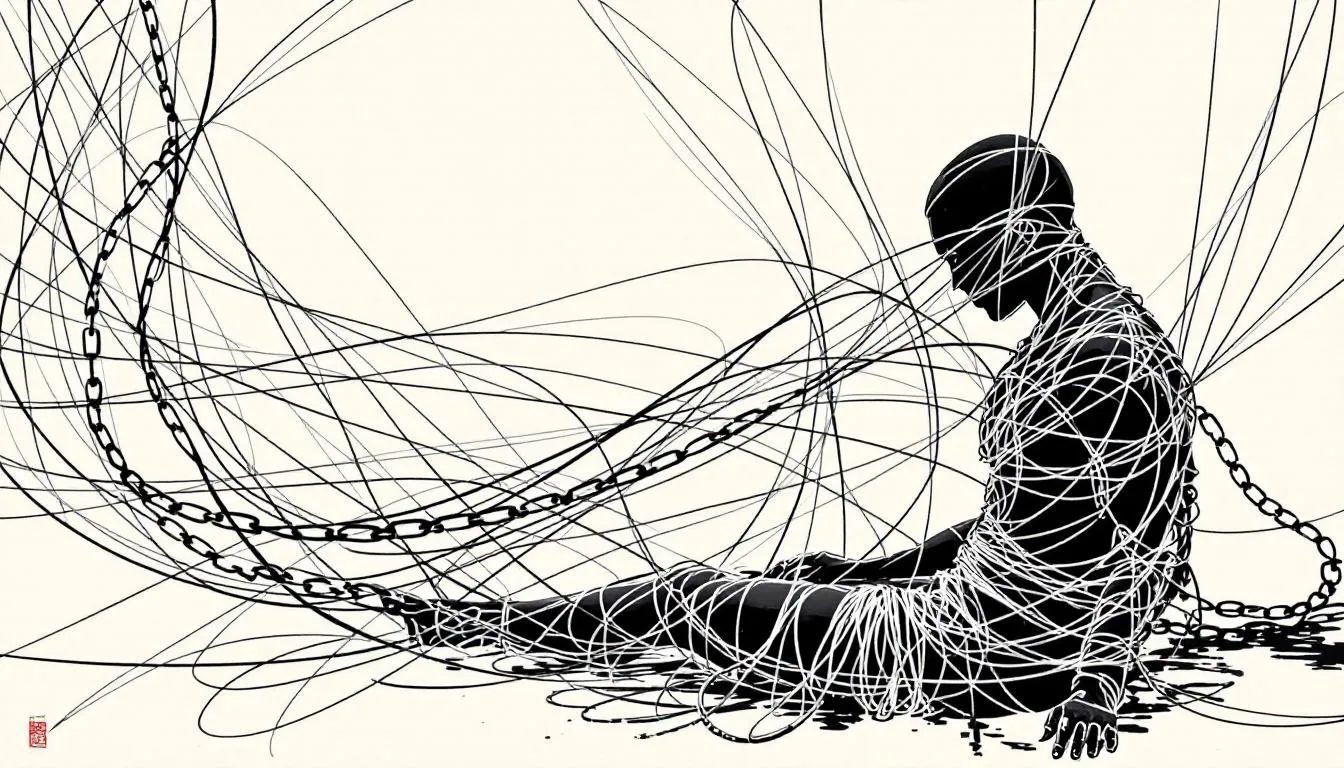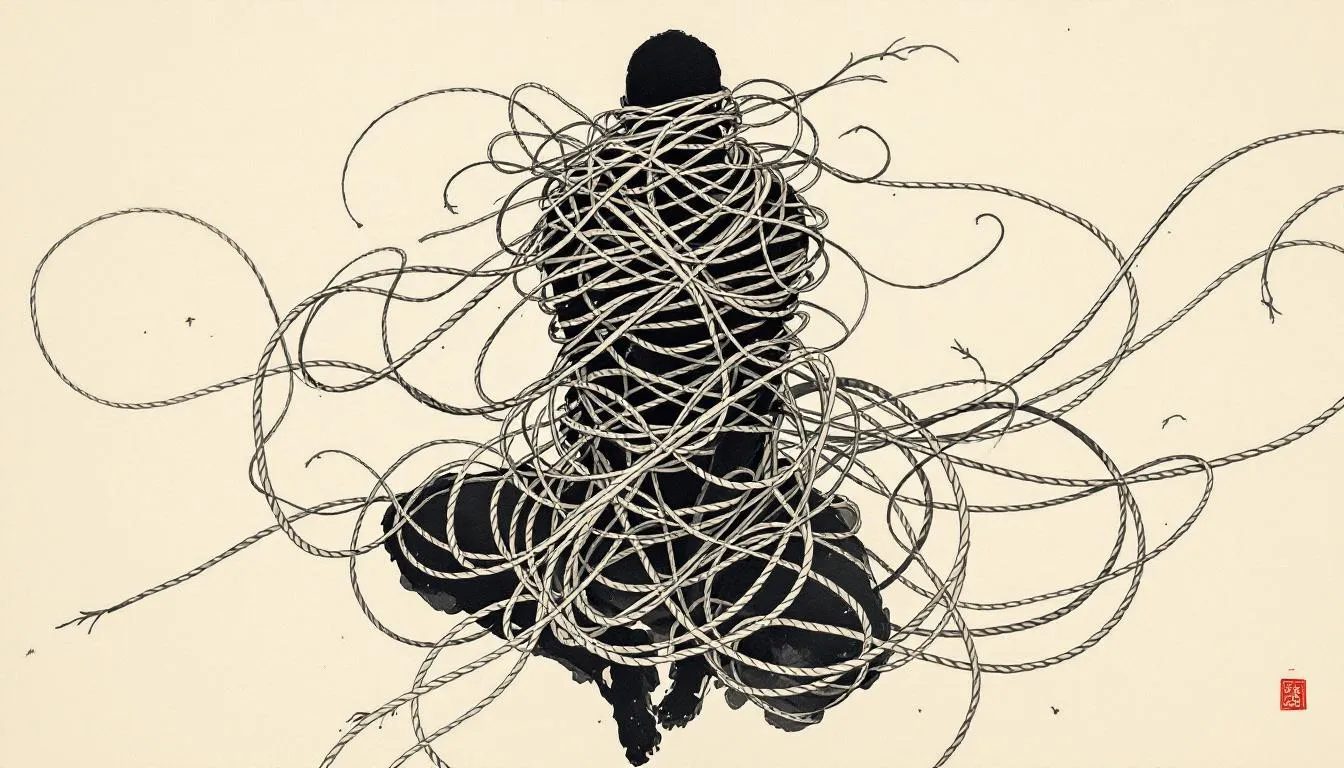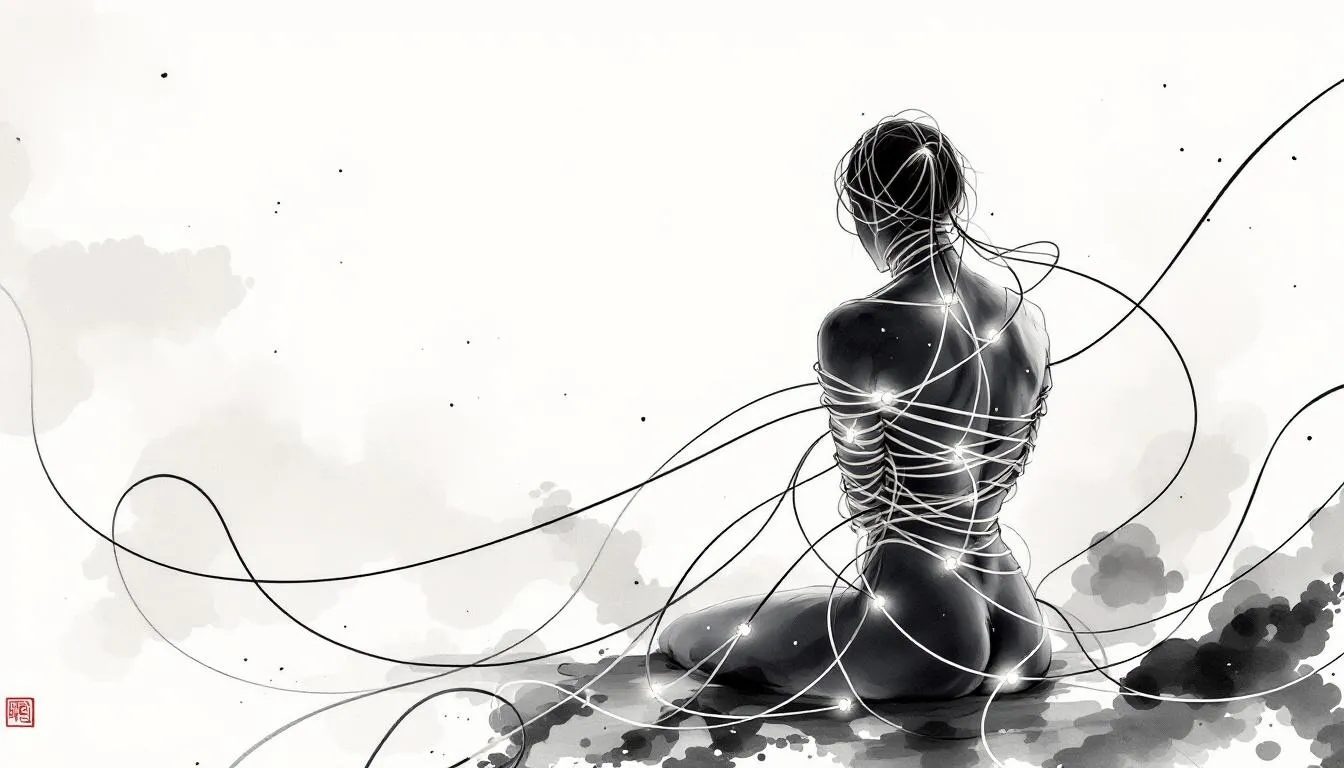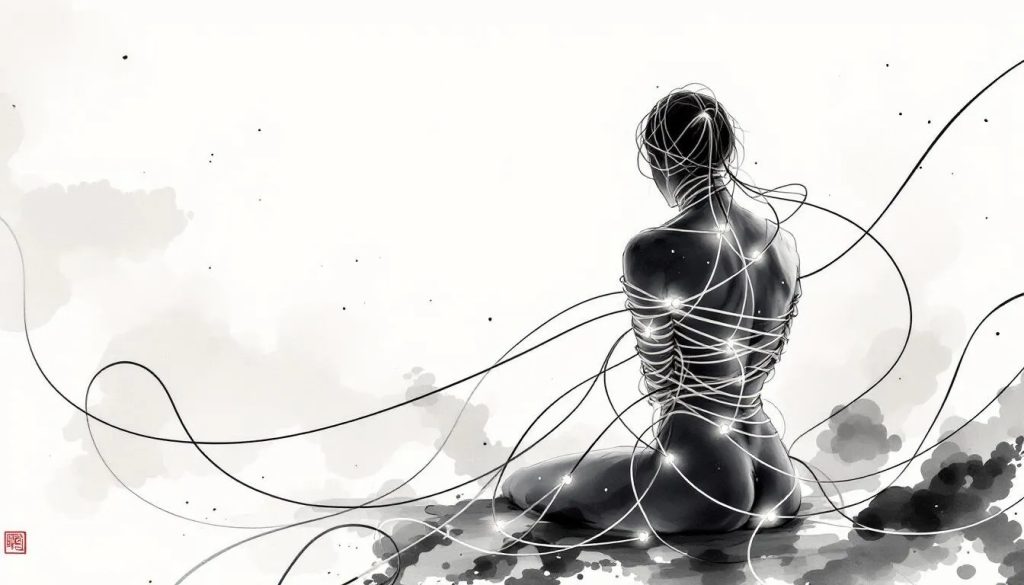Shibari and Kinbaku are forms of Japanese rope bondage. Shibari emphasizes artistic rope designs, while Kinbaku adds an emotional and erotic layer. Both have historical roots in Japan, and together they are often referred to as “shibari kinbaku.” This article covers what they are, their history, and how to practice them.
Table of Contents
ToggleKey Takeaways
- Shibari focuses on the artistic and aesthetic aspects of rope bondage, while Kinbaku emphasizes emotional and erotic connections between participants.
- The historical roots of Shibari and Kinbaku trace back to Hojōjutsu, a martial art for restraining opponents, adapting over time into a revered art form with cultural significance.
- Safety and communication are crucial in Shibari Kinbaku, with practices such as consent, setting boundaries, and regular check-ins ensuring a secure and enjoyable experience.
Understanding Shibari and Kinbaku

Shibari and Kinbaku are two terms often used interchangeably, yet they hold distinct meanings in the world of Japanese rope bondage. Shibari, a generic term in Japanese vocabulary, focuses on the aesthetic aspect of rope bondage, emphasizing intricate and beautiful knots and patterns. On the other hand, shibari or kinbaku delves deeper into the erotic and emotional realms, where the tight binding creates an intimate connection between the participants.
Both shibari and kinbaku are rooted in the Japanese style of bondage, which emphasizes traditional techniques, aesthetics, and the cultural context of Japan.
The inception of Kinbaku was influenced by traditional practices such as Hojōjutsu, a martial art for restraining opponents, as well as elements from kabuki theatre and ukiyo-e woodblock prints. Hojōjutsu, used during the Edo period by Samurai to arrest and restrain prisoners with rope, laid the groundwork for the development of Kinbaku. Rope bondage gained sexual connotations in Japan in the early 1900s through Kabuki theater performances that stylized bondage. This blend of historical and artistic influences has shaped Shibari and Kinbaku into what we know today.
Defining Shibari
Shibari, which means “to tie” in Japanese, is a practice that emphasizes the visual and aesthetic aspects of rope bondage. Practitioners enjoy creating intricate and beautiful knots and patterns, transforming the human body into a living canvas of art.
Shibari is adaptable to all bodies, making it inclusive for people of different body types, ages, and abilities.
Shibari’s emphasis on aesthetics transforms it into a captivating and sensual expressive art form that was created.
Defining Kinbaku
Kinbaku, translating to “tight binding,” reflects a more intimate and sexually charged nature of Japanese rope bondage. This practice goes beyond the visual appeal to create a deep emotional and erotic connection between the participants.
For some, the experience of pain during kinbaku can enhance emotional intimacy and arousal, as the sensations of pain are intertwined with pleasure and psychological release.
Kinbaku’s tight binding transcends physical restraint, fostering a shared intimate experience of the partner’s body. Rope bondage can also serve as a tool for meditation, relaxation, and trust-building between partners, adding a deeper layer to the practice.
Historical Roots of Shibari Kinbaku

Shibari Kinbaku’s history is as intricate as its knots. Shibari is an ancient term meaning “to tie,” predating even the adoption of Chinese writing in Japan. However, its historical narrative has often been romanticized, portraying it as an ancient tradition, even though its modern practice began in the 20th century. In contrast, Kinbaku, meaning “tight binding,” emerged as a more contemporary term in the 20th century. Kinbaku is a term that was first developed and used in May–June 1952 to specifically refer to erotic bondage in Japan. Both practices evolved from Hojōjutsu, originally used for prisoner restraint and torture.
The influential magazine Kitan Club played a significant role in popularizing bondage photography and illustrations in Japan during the mid-20th century, contributing greatly to the dissemination and evolution of kinbaku and shibari culture.
While Shibari is often viewed as a Western interpretation focusing on aesthetics, Kinbaku is recognized for its artistic and emotional context. The evolution of these practices has been shaped by historical, cultural, and artistic influences, making them unique and revered art forms. However, the traditional view considers Shibari as a Western misuse of Japanese vocabulary, as it generically means tying. This distinction highlights the importance of understanding the cultural and linguistic nuances of these terms.
From Hojōjutsu to Shibari
Hojōjutsu, a martial art used for restraining opponents, serves as the historical foundation for modern rope bondage. Primarily used to arrest and restrain prisoners, Hojōjutsu’s techniques, including hojojutsu ties, have transitioned into contemporary practices for BDSM and physical restraint, showcasing the art of rope work and the restrained nature of these techniques. Historically, Shibari was also used in Japan as a means of psychological restraint and publicly shaming prisoners.
Hojōjutsu’s influence is evident in Shibari, underscoring the historical significance of these techniques today.
Evolution Post-1950s
Post-1950s, Shibari and Kinbaku saw a revitalization influenced heavily by art and photography. This resurgence emphasized mastering the aesthetics and techniques, moving away from purely functional ties.
In the same way that European traditions use restraints like shackles for both erotic and symbolic expression, Japanese Shibari incorporates ropes to achieve similar purposes, highlighting a cross-cultural parallel in the use of restraint.
Kinbaku became popular in Japan in the 1950s with the rise of magazines featuring bondage photography. Prominent figures such as Asano Yasutake played crucial roles in redefining Shibari as an art form, and its recognition within artistic communities grew, leading to exhibitions and global adaptations.
The Aesthetics of Japanese Rope Bondage

Aesthetics play a central role in the appeal of Japanese rope bondage. Shibari involves creating intricate designs and aesthetically pleasing patterns with aesthetic rope, turning the human body into a canvas of living art, showcasing the skill of a rope artist, all while embracing the japanese aesthetic.
Shibari’s hallmark is its emphasis on visual beauty and style, with natural fibers like hemp and jute enhancing texture and grip integral to Japanese aesthetics. It often uses natural fiber ropes like jute or hemp, which have better grip than synthetic ropes.
Visual Appeal
Intricate knot designs characterize Shibari, enhancing its visual appeal. These patterns, often referred to as living sculptures, transform the body into a visually captivating artwork, evoking emotional responses from both the practitioner and the observer, while also creating a tangled experience. Many people enjoy the tactile sensation of rope against their skin, which adds to the sensory appeal of the practice.
Sensory Experience
Beyond the visual aesthetics, the sensory experience of Shibari plays a crucial role. Rope serves as an extension of the nawashi’s hands, conveying sensations and emotions. The way the rope is applied influences the pleasure derived from Japanese bondage, creating a unique blend of physical and emotional connection. Being bound can evoke feelings of freedom and release from control for many participants.
Techniques and Styles in Shibari Kinbaku

Shibari Kinbaku offers a wide range of techniques and styles, adaptable to all body types and individual preferences. Its adaptability makes it accessible, fostering personal exploration and self-expression. Shibari is accessible to all genders and body types, adapting to the needs of the participants.
Shibari kinbaku typically involves at least two persons, each with specific roles and responsibilities. Safety and clear communication are essential for every person involved to ensure a consensual and positive experience.
Globally, Shibari has inspired diverse styles influenced by local cultures, blending traditional elements with contemporary practices.
Basic Ties
Basic ties are the foundational techniques in Shibari, providing a starting point for practitioners. Single-column and double-column ties, securing limbs and connecting body parts respectively, form the foundation for more complex designs.
Proper wrist positioning is crucial for safety and comfort. Beginners are encouraged to start with simple ties, such as securing the wrists to the thigh, to ensure both comfort and safety while learning.
Advanced Techniques
Advanced Shibari Kinbaku techniques transform basic ties into complex art forms, elevating the experience. Suspension techniques, which involve lifting the body off the ground, require careful consideration of safety, tension, abilities, and comfort.
Floor ties create intricate patterns while keeping the individual grounded, enhancing both aesthetic and tactile experiences.
Safety and Communication in Shibari Kinbaku

Safety and communication are paramount in Shibari Kinbaku. Key practices include:
- Discussing desires and limitations openly to ensure a safe experience.
- Establishing clear boundaries.
- Setting safe words.
- Regularly checking in with your partner to strengthen trust and ensure comfort.
It’s essential to understand and communicate about your partner’s body, paying attention to their comfort and boundaries throughout the experience.
For beginners, understanding safety and comfort is paramount when starting Shibari.
Safety Protocols
Keeping safety shears or hooks on hand addresses emergency situations during rope play. Regularly assessing the environment, avoiding restrictive ties, and performing check-ins with your partner help prevent accidents. Safety scissors should always be kept nearby when practicing Shibari.
Consent and Boundaries
Consent and boundaries are fundamental to the practice of Shibari. Mutual consent and open communication ensure a safe and enjoyable experience.
Shibari’s soothing nature allows consensual surrender of control, emphasizing mutual respect and understanding, providing a space to enjoy shibari and rest.
The Emotional and Intimate Connection
The emotional and intimate connection in Shibari Kinbaku is deeply intertwined with the physical practice. Kinbaku emphasizes not just the physical binding but also the erotic and emotional experience between participants. While Shibari can involve sex as part of the intimate and erotic experience, it also includes non-sexual, meditative, and emotional bonding practices, all centered on consent and connection. Engaging in Shibari can enhance emotional bonds through high levels of physical contact, fostering a deep sense of connection.
Building Trust
Shibari often evokes feelings akin to a tight, comforting hug, fostering safety and build trust. Enhanced verbal and nonverbal communication between partners requires intense focus and control, allowing them to feel connected.
Enhancing Intimacy
Shibari fosters intimacy, allowing partners to experience various emotional states, such as feeling beautiful or sexy. Tying and being tied enhance empathy and vulnerability, deepening emotional connections and understanding.
Getting Started with Shibari Kinbaku
Starting Shibari Kinbaku requires mastering basic ties and foundational techniques, essential for advancing to complex designs. For beginners, mastering these basics is crucial for safe and effective exploration of Shibari. Free videos are available online, offering accessible resources for beginners to learn foundational shibari kinbaku techniques. Basic ties can provide a fun and satisfying experience without needing complex skills.
Choosing the Right Ropes
Selecting the appropriate ropes is vital for a safe and enjoyable Shibari experience. Commonly used ropes include:
- Cotton ropes: recommended for beginners due to their softness and ease of handling.
- Jute ropes: known for their strength and aesthetics.
- Hemp ropes: also known for their strength and aesthetics.
Maintaining natural fiber ropes and hemp rope by oiling and tying ends to prevent fraying ensures their longevity and safety.
Learning Resources
Accessing learning resources is crucial for safe and skillful Shibari practice. Workshops provide hands-on training with experienced instructors, while books and online tutorials offer foundational knowledge and ability techniques.
Midori explains Shibari as an art form that is accessible to beginners, highlighting its emotional, spiritual, and cultural significance. She emphasizes the importance of respect, consent, and personal exploration in the practice.
A first aid course enhances preparedness for potential incidents during bondage.
Shibari and Cultural Appropriation
Shibari practitioners should educate themselves about its cultural roots and approach the practice with humility and respect. Open dialogue with Japanese practitioners fosters a deeper understanding and appreciation of Shibari’s traditions.
Respectful Practice
Accurate use of the Japanese word terminology shows respect for the respected art form and its cultural significance. The word reflects the deep connection between language and culture.
Cultural sensitivity in Shibari involves recognizing and respecting its historical and cultural roots, including the tradition it embodies.
Global Influence
Post-World War II, rope bondage depictions in fetish magazines contributed to its spread beyond Japan. Rooted in Japanese culture, Shibari has gained global recognition and adaptation over the years. The practice of binding with rope was popularized in Japan after the 1950s and took several decades to be recognized in Western cultures.
Such adaptations have influenced contemporary Shibari practices, enabling diverse interpretations and styles worldwide. The evolution of Shibari blends traditional techniques with modern expressions, highlighting its influence across cultures.
Summary
As we conclude our journey through the intricate world of Shibari Kinbaku, it’s clear that this practice is much more than just rope bondage. It’s an art form deeply rooted in Japanese culture, evolving from its historical origins in Hojōjutsu to its modern expressions influenced by art, photography, and global adaptation. Shibari has also gained a presence in contemporary art, notably through the works of photographers like Nobuyoshi Araki. Rope is a significant material in Japanese culture, used for various purposes beyond bondage, including in Shinto shrines and sumo wrestling rings. The visual and sensory appeal of Shibari, combined with its techniques and styles, makes it a unique and captivating practice.
Safety, communication, and consent are paramount in Shibari Kinbaku, ensuring a safe and enjoyable experience for all participants. The emotional and intimate connections fostered through Shibari can deepen relationships and create a profound sense of trust and intimacy. Shibari can also be a means of emotional catharsis for some practitioners. As you embark on your Shibari journey, remember to approach it with respect for its cultural roots, a commitment to safety, and an openness to the emotional and physical experiences it offers.
Frequently Asked Questions
What is the difference between Shibari and Kinbaku?
The main difference is that Shibari is all about creating beautiful and intricate rope patterns, while Kinbaku focuses more on the intimate and erotic bonds between partners. Each has its own unique appeal!
How did Shibari evolve from Hojōjutsu?
Shibari evolved from Hojōjutsu, originally a martial art focused on restraining opponents, into a form of artistic and intricate bondage used in modern BDSM. It’s fascinating how these ancient techniques transformed into a contemporary practice!
What are the basic ties in Shibari?
The basic ties in Shibari are the single-column tie, which secures one limb, and the double-column tie, connecting two body parts. Mastering these techniques is key to building your skills for more intricate designs.
How can I practice Shibari safely?
To practice Shibari safely, always keep safety shears handy, avoid ties that restrict breathing, and make sure to check in with your partner frequently. Regularly assess your environment to ensure safety at all times.
How can I learn more about Shibari?
To really dive into Shibari, consider joining workshops for hands-on experience, read up on the practice, and explore online tutorials. And hey, a first aid course might not be a bad idea to keep safety in check!
Irresistible experts in bondage & BDSM
Albums that ignite curiosity in bondage & BDSM

A collection of sensual images to inspire your desires
Raw and Unfiltered (6)

A collection of sensual images to inspire your desires
Barely Covered (6)

A collection of sensual images to inspire your desires
For Your Eyes Only (6)

A collection of sensual images to inspire your desires
Gloss and Glow (6)

A collection of sensual images to inspire your desires
Peek A Boo (6)

A collection of sensual images to inspire your desires
Elegant Temptation (6)
Erotic Stories to Ignite Your Imagination

A tantalizing tale of hidden passions and forbidden encounters that will leave you breathless...
The Secret Desires of a Married Woman

What started as innocent flirting turned into something much more intense...
Office Romance Gone Wild

She hired him to clean the pool, but he ended up fulfilling all her deepest fantasies...
The Pool Boy's Secret
Sensual Videos to Inspire Intimacy

Learn how to give the perfect sensual massage that will drive your partner wild
Sensual Massage Techniques

Master the subtle art of teasing to build incredible anticipation
The Art of Teasing

Combine yoga and intimacy for a deeply connecting experience
Intimate Yoga for Couples
Arousing Audio Experiences

A relaxing yet arousing meditation to awaken your senses
Guided Erotic Meditation

Soothing whispers and sensual sounds to help you unwind
Whispers of Desire

An erotic audio story set in a mysterious library
The Forbidden Library
Lana Steele
BDSM writer & enthusiast. Believer in consent, kink, and the power of vulnerability. Here to explore pleasure with curiosity—and a little wickedness.







Leave a Response
How can we help?
Still have questions?
Ask your question below and we'll show you the most relevant answers.
Browse by Category
community
Do I need an account to purchase albums?
Yes, speakmydesires needs you to have an account for album purchases, which will have great deals and discounts!